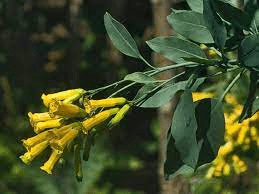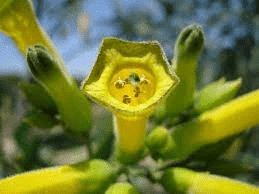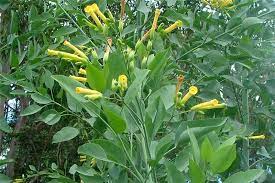Nicotiana glauca, commonly known as Tree Tobacco is a species of flowering plant belonging to the nightshade family, Solanaceae. Native to South America, particularly Argentina and Bolivia,
Tree Tobacco has become naturalized in various parts of the world, including North America, Europe, and Australia. This plant is characterized by its rapid growth, reaching heights of up to 6 meters.
The Tree Tobacco plant features large, ovate leaves that have a bluish-green tint, contributing to its glaucous appearance. The tubular flowers are typically a pale yellow color and are arranged in elongated clusters. The plant produces numerous seeds within its capsules, aiding in its ability to spread rapidly.
While Nicotiana glauca is a member of the tobacco genus, it’s important to note that the levels of nicotine in Tree Tobacco are much lower compared to cultivated tobacco plants (Nicotiana tabacum). Nevertheless, all parts of the plant contain alkaloids, including nicotine, which can be toxic. The consumption of Tree Tobacco is not recommended due to the potential health risks associated with these alkaloids.
In some regions, Tree Tobacco is considered an invasive weed due to its ability to colonize disturbed areas, roadsides, and waste places. Its rapid growth and prolific seed production can lead to the displacement of native vegetation.
Despite its invasive nature, some people cultivate Nicotiana glauca for ornamental purposes, attracted to its tall stature and unique foliage. However, caution should be exercised, and it’s crucial to prevent the plant’s spread into natural ecosystems.
In summary, Nicotiana glauca, or Tree Tobacco, is a hardy plant with distinctive bluish-green leaves and yellow flowers. While it may be cultivated for ornamental reasons in some regions, its invasive tendencies and potential toxicity warrant careful consideration and responsible management.
The Botanical Description of Nicotiana glauca
1. Perennial Shrub: Nicotiana glauca, commonly known as Tree Tobacco, is a perennial shrub belonging to the Solanaceae family. It exhibits a woody stem, reaching heights of up to 5 meters, with a distinctive bluish-green hue.
2. Simple Leaves: The leaves of Nicotiana glauca are simple, elongated, and alternate along the branches. They are characterized by a glaucous surface, contributing to the plant’s unique appearance.
3. Tubular Flowers: The plant produces tubular, fragrant flowers with a yellow hue. These flowers are arranged in clusters, creating a visually appealing display.
4. Nicotine Content: One of the notable features of Nicotiana glauca is its nicotine content, although in lower concentrations compared to other Nicotiana species. This alkaloid contributes to the plant’s traditional and medicinal uses.
5. Fast Growth: Tree Tobacco is known for its rapid growth, making it adaptable to various environmental conditions. This characteristic has led to its naturalization in different regions.
6. Capsule Fruits: The plant’s reproductive structures consist of capsule fruits that contain numerous small seeds. These capsules play a role in the dispersal and propagation of the species.
7. Drought Tolerance: Nicotiana glauca exhibits a high degree of drought tolerance, enabling it to thrive in arid and semi-arid regions.
8. Woody Stem: As a woody shrub, Tree Tobacco develops a sturdy stem with a branching pattern. This structural aspect contributes to the overall resilience of the plant.
9. Invasive Characteristics: Due to its fast growth and adaptability, Nicotiana glauca is considered invasive in some regions, outcompeting native vegetation.
10. Attractive to Pollinators: The tubular flowers of Tree Tobacco attract pollinators such as bees and butterflies, fostering ecological interactions.
11. Allelopathic Properties: Nicotiana glauca exhibits allelopathic properties, releasing biochemicals that may affect the growth of nearby plants.
12. Medicinal Uses: Apart from its invasive tendencies, certain traditional practices involve using Nicotiana glauca for medicinal purposes, although caution is advised due to its nicotine content.
The Geographic Distribution of Nicotiana glauca

1. Native to South America: Nicotiana glauca is native to South America, specifically found in countries like Argentina and Bolivia. Its natural habitat includes regions with a Mediterranean climate.
2. Naturalized in Various Regions: Due to its adaptability, Tree Tobacco has naturalized in diverse regions worldwide, including North America, Europe, Africa, Asia, and Oceania.
3. Arid and Semi-Arid Environments: The plant thrives in arid and semi-arid environments, demonstrating its ability to withstand low water availability.
4. Disturbed Areas: Nicotiana glauca often establishes itself in disturbed areas, such as roadsides, abandoned fields, and areas with disrupted ecosystems.
5. Coastal Regions: The species can be found in coastal regions, showcasing its versatility in tolerating different soil types and saline conditions.
6. Altitudinal Range: Tree Tobacco exhibits a wide altitudinal range, growing from sea level to higher elevations in mountainous terrain.
7. Invasive Presence: Invasive populations of Nicotiana glauca are reported in regions with favorable climatic conditions, leading to concerns about its impact on local ecosystems.
8. Human-Mediated Spread: The plant’s distribution has been facilitated by human activities, including accidental introductions and intentional cultivation for ornamental or medicinal purposes.
9. Ecological Impact: The invasive nature of Nicotiana glauca raises ecological concerns, as it may outcompete native vegetation and alter local biodiversity.
10. Management Challenges: Controlling the spread of Tree Tobacco poses challenges, and efforts are underway in some regions to manage its impact on ecosystems.
11. Climate Sensitivity: While adaptable, Nicotiana glauca’s distribution is influenced by climatic factors, and its presence may be limited in extremely cold or hot environments.
The Chemical Composition of Nicotiana glauca
1. Nicotine: Nicotiana glauca contains nicotine, an alkaloid with potential pharmacological effects. However, the concentration of nicotine in Tree Tobacco is generally lower than in other Nicotiana species.
2. Alkaloids: Besides nicotine, other alkaloids may be present in Nicotiana glauca, contributing to its traditional and medicinal uses.
3. Flavonoids: Flavonoids, known for their antioxidant properties, may be found in the plant. These compounds play a role in the overall chemical profile of Tree Tobacco.
4. Terpenoids: Terpenoids, including essential oils, are part of the chemical composition, contributing to the plant’s aromatic characteristics.
5. Phenolic Compounds: Nicotiana glauca may contain phenolic compounds, which are known for their antioxidant and anti-inflammatory properties.
6. Volatile Compounds: The plant’s leaves and flowers may release volatile compounds, contributing to its distinctive fragrance.
7. Tannins: Tannins, with astringent properties, may be present in Tree Tobacco. These compounds have implications for the plant’s traditional uses.
8. Coumarins: Coumarins, aromatic compounds with various biological activities, may be part of the chemical makeup of Nicotiana glauca.
9. Glycosides: The presence of glycosides, including potential bioactive compounds, adds to the chemical diversity of the plant.
10. Organic Acids: Certain organic acids may be found in the plant, influencing its taste and potential physiological effects.
11. Lipids: Lipids, including fatty acids, may contribute to the nutritional content of Nicotiana glauca.
12. Proteins: The plant contains proteins, essential for various biological functions.
13. Minerals: Nicotiana glauca accumulates minerals from the soil, and their presence in different parts of the plant contributes to its nutritional content.
14. Allelopathic Compounds: Allelopathic compounds released by the plant may affect neighboring vegetation, influencing its chemical interactions within ecosystems.
Read Also: Rose Chafer: Description, Damages Caused, Control and Preventive Measures
The Medicinal Health Benefits Of Nicotiana glauca (Tree Tobacco)

1. Traditional Respiratory Uses: In some traditional practices, Nicotiana glauca has been used for respiratory purposes, with applications ranging from smoking blends to steam inhalation.
2. Analgesic Properties: Certain compounds present in Tree Tobacco may have analgesic effects, contributing to its use for pain relief in traditional contexts.
3. Potential Anti-Inflammatory Effects: Components such as flavonoids and phenolic compounds suggest potential anti-inflammatory properties, though scientific validation is needed.
4. Ritualistic and Shamanic Practices: In certain cultures, Nicotiana glauca is used in ritualistic and shamanic practices for its psychoactive and spiritual effects.
5. Traditional Healing Practices: Some traditional healers incorporate Tree Tobacco into their practices, attributing various health benefits to its use.
6. Antioxidant Activity: The presence of flavonoids and other antioxidants in Nicotiana glauca may contribute to its potential antioxidant activity.
7. Cultural Significance: Beyond its potential health benefits, Tree Tobacco holds cultural significance in certain communities, playing a role in rituals and ceremonies.
8. Traditional Smoking Blends: The leaves of Nicotiana glauca are sometimes included in traditional smoking blends, with users attributing specific effects to its consumption.
9. Ethnobotanical Uses: Ethnobotanical studies highlight the diverse traditional uses of Tree Tobacco, shedding light on its cultural importance.
10. Psychoactive Properties: The psychoactive effects of Nicotiana glauca, linked to its nicotine content, are sometimes explored in traditional contexts.
11. Potential Wound Healing: In some traditional applications, Nicotiana glauca is used for wound healing, with constituents potentially contributing to tissue repair.
12. Relaxant Effects: Traditional uses suggest that Tree Tobacco may have relaxant effects, influencing its utilization in certain cultural practices.
13. Ethnomedicinal Knowledge: The traditional knowledge surrounding the medicinal uses of Nicotiana glauca reflects the ethnomedicinal importance of the plant.
14. Management of Respiratory Conditions: Some traditional practices involve using Tree Tobacco for managing respiratory conditions, although scientific evidence is limited.
15. Cultural Preservation: Recognizing and understanding the medicinal uses of Nicotiana glauca contributes to the preservation of cultural knowledge and practices.
16. Potential Antimicrobial Properties: While not thoroughly researched, certain compounds in Tree Tobacco may exhibit antimicrobial properties, aligning with its traditional use in specific contexts.
The Methods of Usage to Achieve the Provided Health Benefits Of Nicotiana glauca (Tree Tobacco)
1. Smoking Blends: Traditional smoking blends may include Nicotiana glauca leaves, with users attributing specific effects to the inhalation of the smoke.
2. Steam Inhalation: For respiratory benefits, steam inhalation involving the leaves or extracts of Tree Tobacco is practiced in some traditional settings.
3. Poultices: Leaves or plant parts may be used in poultices for topical applications, potentially aiding in wound healing or addressing skin conditions.
4. Ritualistic or Shamanic Practices: In certain cultural practices, Nicotiana glauca is used in rituals or shamanic ceremonies for its psychoactive and spiritual effects.
5. Traditional Healing Formulations: Traditional healers may prepare specific formulations, combining Tree Tobacco with other herbs to address various health concerns.
6. Chewing or Snuff: In some traditions, chewing the leaves or using them as snuff is practiced, often associated with specific cultural or ritualistic activities.
7. Infused Oils: Creating infused oils from Nicotiana glauca may provide a method for topical applications, potentially harnessing its beneficial compounds.
8. Ethnobotanical Preparations: Ethnobotanical practices involve preparing various formulations or infusions based on traditional knowledge of the plant’s properties.
9. Tea or Infusions: Infusions or teas made from Nicotiana glauca leaves may be consumed for potential respiratory or relaxant effects.
10. Ritualistic Smoking: In cultural or ritualistic contexts, Tree Tobacco may be used in specific smoking practices, often with symbolic or spiritual significance.
11. Traditional Smoking Ceremonies: Some cultures engage in traditional smoking ceremonies, incorporating Nicotiana glauca for its psychoactive and ritualistic aspects.
12. Poultices for Pain Relief: Poultices made from Nicotiana glauca may be applied to areas of the body experiencing pain, potentially providing analgesic effects.
The Side Effects Of Using Nicotiana glauca Medicinal Plant
1. Nicotine-Related Effects: The presence of nicotine in Nicotiana glauca raises concerns about potential nicotine-related effects, including addiction and adverse health impacts.
2. Respiratory Risks: Smoking or inhaling Nicotiana glauca smoke may pose respiratory risks, and prolonged use may contribute to respiratory issues.
3. Skin Irritation: Topical applications or poultices may lead to skin irritation in some individuals, emphasizing the importance of patch testing.
4. Psychoactive Effects: The psychoactive properties of Nicotiana glauca, while culturally significant, may pose risks if not used responsibly, especially in ritualistic or shamanic contexts.
5. Potential Allergic Reactions: Some individuals may be sensitive to components of Tree Tobacco, leading to potential allergic reactions. Patch testing is advisable.
6. Gastrointestinal Discomfort: Ingesting Nicotiana glauca may cause gastrointestinal discomfort, and excessive consumption should be avoided.
7. Interaction with Medications: Nicotiana glauca may interact with certain medications, particularly those affecting the central nervous system, cardiovascular system, or respiratory system.
8. Sedative Effects: Relaxant effects associated with Nicotiana glauca may pose risks, especially when activities requiring full alertness are involved.
9. Hypotensive Effects: Compounds in Tree Tobacco may lower blood pressure, requiring monitoring for individuals with low blood pressure or those on hypertension medications.
10. Photosensitivity: Prolonged exposure to sunlight after applying Nicotiana glauca extracts topically may lead to photosensitivity reactions.
11. Respiratory Sensitivity: Individuals with respiratory conditions should use Nicotiana glauca for steam inhalation cautiously, seeking advice from healthcare professionals.
12. Pregnancy and Lactation: Pregnant or lactating individuals should use Tree Tobacco cautiously, with consultation from healthcare providers due to limited safety information.
13. Potential Drug Interactions: Nicotiana glauca may interact with medications, emphasizing the importance of informing healthcare providers about its use.
14. Impact on Blood Sugar Levels: Individuals managing diabetes should monitor blood sugar levels regularly when using Nicotiana glauca for potential effects on blood glucose.
Read Also: Maize Streak Virus: Description, Damages Caused, Control and Preventive Measures
The Scientific Research and Studies of Nicotiana glauca (Tree Tobacco)

1. Nicotine Content Studies: Scientific research has focused on the nicotine content of Nicotiana glauca, exploring its concentrations and implications for health.
2. Respiratory Effects: Studies have investigated the respiratory effects of inhaling Tree Tobacco smoke, providing insights into potential risks and impacts on lung health.
3. Psychoactive Properties: Research has explored the psychoactive properties of Nicotiana glauca, shedding light on its cultural significance and potential neurological effects.
4. Nicotiana glauca Alkaloids: Studies have identified various alkaloids in Tree Tobacco, contributing to its chemical composition and potential pharmacological activities.
5. Antioxidant and Anti-Inflammatory Activity: Scientific investigations have assessed the antioxidant and anti-inflammatory activity of Nicotiana glauca, exploring the potential health benefits associated with these properties.
6. Cultural and Ethnobotanical Research: Ethnobotanical studies have delved into the cultural and traditional uses of Tree Tobacco, documenting its significance in different communities.
The Safety Precautions and Recommendations In Using Nicotiana glauca (Tree Tobacco) Medicinal Plant
1. Nicotine Sensitivity Testing: Individuals using Nicotiana glauca should be aware of their sensitivity to nicotine. Conducting a sensitivity test before widespread use helps identify potential adverse reactions.
2. Controlled Dosage: When using Tree Tobacco for its potential health benefits, practitioners should exercise caution in controlling the dosage. Avoid excessive intake to prevent nicotine-related issues.
3. Avoiding Prolonged Use: Long-term use of Nicotiana glauca may pose risks associated with nicotine exposure. Limiting the duration of use is advisable to minimize potential health concerns.
4. Respiratory Precautions: Individuals with respiratory conditions, such as asthma or chronic obstructive pulmonary disease (COPD), should consult healthcare professionals before using Nicotiana glauca for respiratory purposes.
5. Patch Testing for Topical Applications: Before applying Tree Tobacco extracts topically, perform a patch test to check for skin sensitivity or irritation. This precaution is essential for preventing adverse skin reactions.
6. Responsible Smoking Practices: In cultural or ritualistic contexts where smoking blends containing Nicotiana glauca are used, practitioners should adopt responsible smoking practices to minimize potential health risks.
7. Monitoring Blood Pressure: Due to the potential hypotensive effects of Tree Tobacco, individuals with low blood pressure or those on hypertension medications should monitor their blood pressure regularly.
8. Pregnancy and Lactation Consultation: Pregnant or lactating individuals should consult healthcare providers before using Nicotiana glauca due to limited safety information in these populations.
9. Awareness of Photosensitivity: Individuals using Tree Tobacco extracts topically should be aware of potential photosensitivity reactions. Avoid prolonged sun exposure after applying the extracts to minimize the risk of skin issues.
10. Respiratory Sensitivity Monitoring: Individuals using Nicotiana glauca for steam inhalation should monitor respiratory sensitivity. If any adverse effects occur, discontinue use and seek medical advice.
11. Caution with Central Nervous System Medications: Due to potential interactions, individuals taking medications that affect the central nervous system should use Nicotiana glauca cautiously, informing healthcare providers about its use.
12. Regular Blood Sugar Monitoring: Individuals managing diabetes should monitor blood sugar levels regularly when using Tree Tobacco. Any fluctuations should be discussed with healthcare professionals.
13. Safety Considerations for Individuals with Skin Conditions: Individuals with pre-existing skin conditions should exercise caution when using Nicotiana glauca topically. Consulting dermatologists for personalized advice is recommended.
14. Responsible Cultural Practices: Practitioners engaging in cultural or ritualistic practices involving Nicotiana glauca should ensure responsible and informed use, respecting the plant’s psychoactive properties.
15. Disclosing Nicotiana glauca Use to Healthcare Providers: Individuals using Nicotiana glauca should inform their healthcare providers about its use, especially when seeking medical advice or undergoing treatments.
16. Legal Considerations: Be aware of the legal status of Nicotiana glauca in your region. Adhering to local regulations ensures responsible and legal use of the medicinal plant.
FAQs About Nicotiana glauca (Tree Tobacco) Medicinal Plant
1. What is the botanical description of Nicotiana glauca (Tree Tobacco)?
Tree Tobacco (Nicotiana glauca) is a perennial shrub with a woody stem and elongated, glaucous leaves. It produces tubular, yellow flowers in clusters and contains nicotine in its composition.
2. Where is Nicotiana glauca naturally found?
Native to South America, Nicotiana glauca is found in countries like Argentina and Bolivia. It has also naturalized in various regions globally, adapting to diverse climates.
3. What are the potential health benefits of Nicotiana glauca?
Tree Tobacco is traditionally associated with respiratory uses, analgesic properties, and potential anti-inflammatory effects. It also plays a role in ritualistic and shamanic practices.
4. How can Nicotiana glauca be used for medicinal purposes?
Nicotiana glauca can be used through smoking blends, steam inhalation, poultices, ritualistic practices, traditional healing formulations, teas, and topical applications.
5. What are the side effects of using Nicotiana glauca?
Potential side effects include nicotine-related effects, respiratory risks, skin irritation, psychoactive effects, allergic reactions, gastrointestinal discomfort, and interactions with medications.
6. Is Nicotiana glauca safe during pregnancy and lactation?
Pregnant or lactating individuals should use Tree Tobacco cautiously and consult healthcare providers due to limited safety information in these populations.
7. Can Nicotiana glauca interact with medications?
Nicotiana glauca may interact with medications, especially those affecting the central nervous, respiratory, or cardiovascular systems. It’s crucial to inform healthcare providers about its use.
8. What precautions should be taken when using Nicotiana glauca topically?
Patch testing for skin sensitivity is advisable before applying Nicotiana glauca topically. This precaution helps prevent adverse skin reactions.
9. How can Nicotiana glauca be used responsibly in cultural practices?
In cultural or ritualistic practices involving Nicotiana glauca, practitioners should adopt responsible smoking practices and ensure informed and respectful use of the plant’s psychoactive properties.
10. Can Tree Tobacco be legally used?
The legal status of Nicotiana glauca may vary. Users should be aware of local regulations to ensure responsible and legal use of the medicinal plant.
Read Also: The Impact Of Hazardous Waste Disposal in Los Angeles

